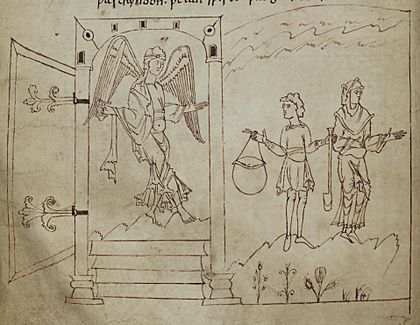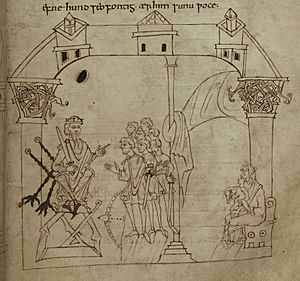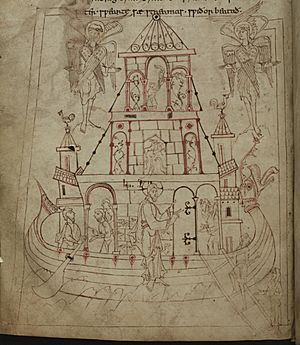Junius manuscript facts for kids
The Junius manuscript is one of the four most important books of Old English literature. It was written in the 10th century, which is over 1000 years ago! This special book contains poems about stories from the Bible. These poems are written in Old English, which was the language spoken in England during the Anglo-Saxon period.
Today, experts believe the manuscript holds four main poems. They have given them the names Genesis, Exodus, Daniel, and Christ and Satan. We don't know who wrote these poems. For a long time, people thought a poet named Cædmon wrote them. Because of this, the book was often called the Cædmon manuscript. However, this idea is no longer believed because the poems are very different from each other.
The book is now called the Junius manuscript because of a scholar named Franciscus Junius. He was the first person to study and publish its contents. He later gave the manuscript to Oxford University. You can find it today in the Bodleian Library under the special code MS Junius 11.
Contents
What It's Called and When It Was Made
This old book is now known as the "Junius manuscript." It used to be called the "Cædmon manuscript." This was because people once thought the poems inside were written by a poet named Cædmon. But this idea is not considered true anymore. So, the book is usually called "the Junius manuscript" or "Codex Junius." Sometimes, it's called by its library code, "MS Junius 11." The name 'Junius' comes from Franciscus Junius. He was the first to publish the poems in 1655.
Experts have studied the handwriting and style of the manuscript. They believe it was first put together around the year 1000 AD. More recent studies suggest it might have been started a bit earlier, between 960 and 1000 AD. This date is based on looking at the text, handwriting, and pictures all together.
The manuscript was created in two main steps. The first part, called Liber I, has the poems Genesis, Exodus, and Daniel. One person wrote all of this section. The second part, Liber II, contains the poem Christ and Satan. The book also has many drawings. These drawings show the "Winchester style," which was popular in that time and place. It seems two different artists worked on the manuscript. The first writer even left empty spaces for more drawings that were never finished.
Amazing Illustrations
The Junius manuscript has many beautiful line drawings. These pictures show the events described in the poems. The people who wrote the book left empty spaces for more drawings. This means they planned for the whole book to be illustrated. However, the artwork was never finished. Only about one-third of the planned drawings were completed.
Having so many illustrations is very unusual for Anglo-Saxon poems. This suggests that the manuscript was considered very important. It might have been used for religious teaching or for people to read for their faith.
What's Inside the Book
The names of the poems we use today were made up by modern scholars. The original manuscript does not give them titles. Like most Anglo-Saxon writings, the poems do not say who wrote them. We also don't know exactly when or where they were created.
The Genesis Poem

The poem Genesis is a retelling of the first part of the Biblical book of Genesis. It starts with the Creation story. It goes all the way up to Abraham being tested to sacrifice his son Isaac (Genesis 22).
Experts now know that this poem is actually made of two different parts. These are called Genesis A and Genesis B. Genesis B is lines 235-851 of the poem we have today. It seems this part was added into an older poem to create the current text.
Genesis B is especially interesting to scholars. It appears to be a translation from an older poem written in Old Saxon. Old Saxon was a language spoken in what is now northern Germany. This idea was first suggested in 1875. It was later confirmed when a piece of Old Saxon poetry was found in 1894 that matched part of the poem. Genesis B is special because it tells the story of the fall of Satan and the fall of humans. It is written in a grand, epic style. Some people think it might have influenced famous works like Beowulf and even Milton's Paradise Lost.
The Exodus Poem
The poem Exodus is not just a simple retelling of the Biblical book. Instead, it tells the story of the Israelites' escape from Egypt. It also describes their amazing Crossing of the Red Sea. This poem is written like a "heroic epic." This style is similar to other Old English poems like Andreas or Beowulf. It is one of the most complex and difficult Old English poems. Many scholars still debate its meaning.
Exodus uses a traditional "heroic style" for its Biblical story. Moses is shown as a great general. The battle scenes are full of military images. The destruction of the Egyptians in the Red Sea is told like a typical battle scene from other Old English poems. It even includes a "Beast of Battle" idea, which was common in poetry back then.
At one point, the main story pauses to tell the stories of Noah and Abraham's sacrifice of Isaac. Some scholars think this change of topic is part of the "epic style," like similar side stories in Beowulf. Others believe it was added later. Edward B. Irving edited the poem twice. In his first edition, he took out the Noah and Abraham part as a separate poem. But later, he changed his mind. He realized it was an important part of the Exodus poem. There are old religious writings that connect the crossing of the Red Sea with these other stories.
In recent years, scholars have looked at the poem's deeper meanings. They explore how it might connect to Christian ideas. For example, Peter J. Lucas has suggested the poem is an allegory. This means it's a story with a hidden meaning about Christians fighting against the devil. The Crossing of the Red Sea has been seen as a symbol for baptism. It also might represent entering Heaven. The Pharaoh in the poem could be linked to Satan through some subtle word choices. However, these ideas are still discussed and debated. A balanced view would say that some parts of the Exodus story have symbolic meanings, but not the whole poem.
The Daniel Poem
This is a short poem that retells parts of the book of Daniel. It focuses especially on the story of Shadrach, Meshach, and Abednego in the Fiery Furnace. It covers the first five chapters of the Book of Daniel.
The Christ and Satan Poem
This poem has three parts. It describes the Fall of Satan. It also tells about Christ's harrowing of Hell, which is a story from an old Christian text called the Gospel of Nicodemus. Finally, it covers Christ's temptation in the desert.
More About the Manuscript
Here are some ways to see or read the Junius manuscript:
- The Cædmon manuscript of Anglo-Saxon Biblical poetry: Junius XI in the Bodleian , edited by Israel Gollancz (London: Oxford University Press, 1927.)
- You can see a full digital copy online through digital Bodleian: A complete digital facsimile.
- A digital copy with notes, written text, and translations was released on CD in 2004.
- Several poems from MS Junius 11 are available with digital images of their pages and translations in the Old English Poetry in Facsimile Project.
See also
- Anglo-Saxon literature
- Exeter Book
- History of the English Bible
- Nowell Codex
- Old English Bible translations
- Vercelli Book



